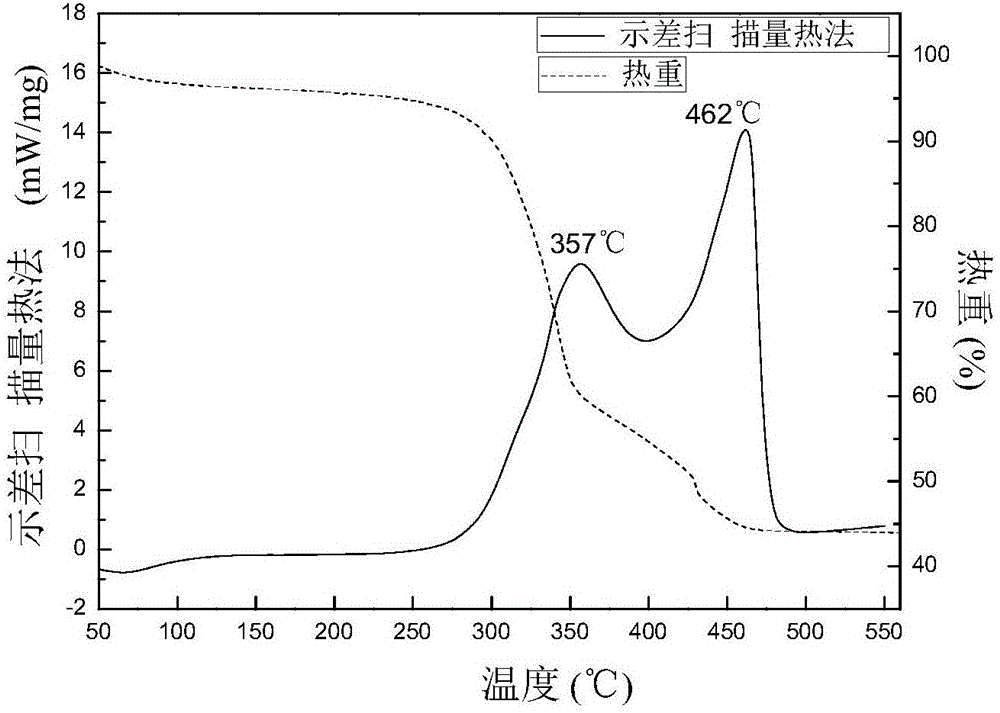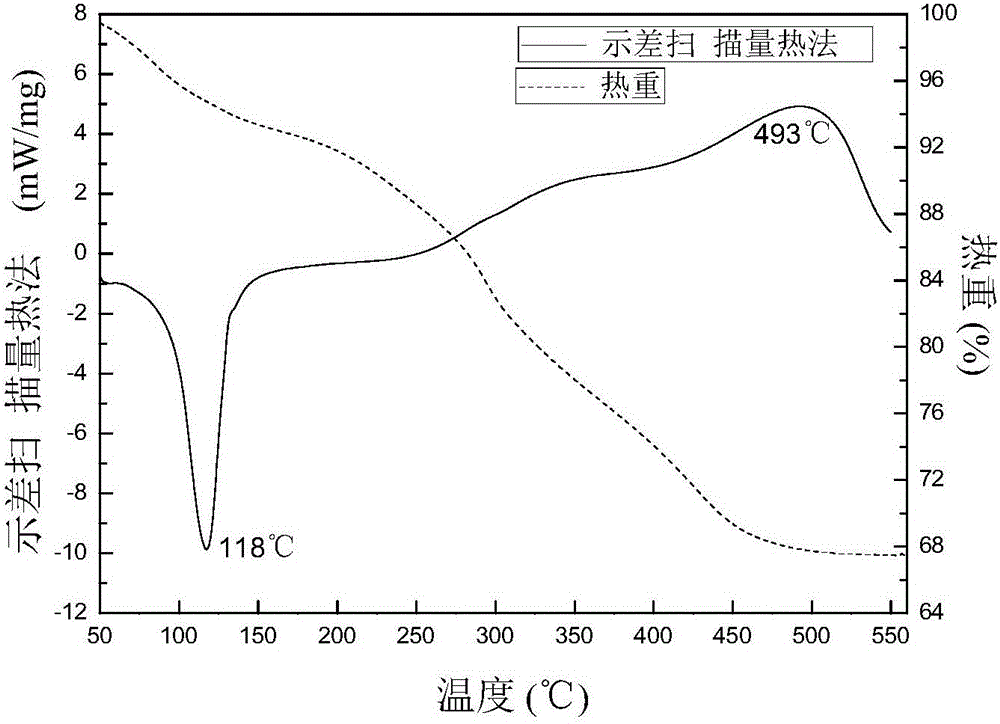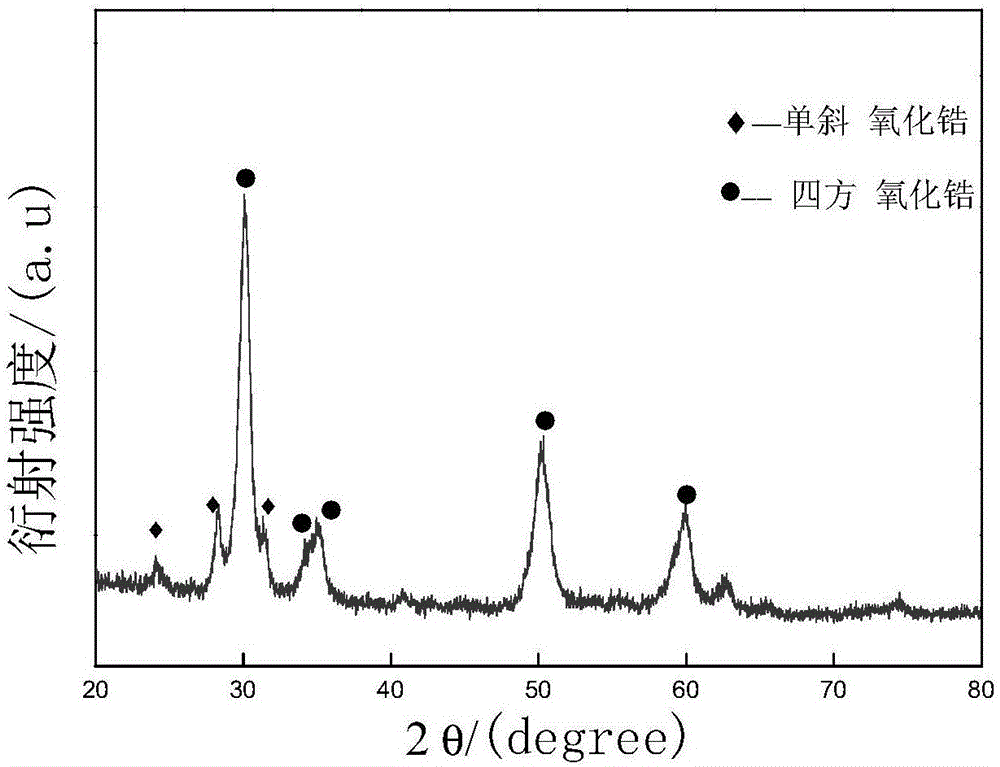Method for preparing multi-hollow zirconium oxide fiber by using cotton fiber
A technology of zirconia fiber and cotton fiber, which is applied to the chemical characteristics of fibers, textiles and papermaking, etc., can solve the problems of easy formation of broken filaments, inconsistent hollow structure, and many gaps between zirconia grains, so as to prevent infrared energy. The effect of loss, excellent thermal insulation performance, and excellent thermal insulation performance
- Summary
- Abstract
- Description
- Claims
- Application Information
AI Technical Summary
Problems solved by technology
Method used
Image
Examples
Embodiment 1
[0029] Preparation mass percent concentration is 4% zirconium oxychloride solution, namely zirconium oxychloride solid (ZrOCl2 8H2O) 4.71g, yttrium nitrate (Y(NO3)3 6H2O) 0.353g, tin chloride (SnCl4 5H2O) 0.3 g, polyvinylpyrrolidone (PVPK-30) 0.375g, i.e. tin tetrachloride: polyvinylpyrrolidone (S / P value) is 0.8:1, the zirconium oxychloride impregnation salt solution that solvent distilled water 60ml configures, after drying Soak the cotton fibers in the solution for 10 minutes, and stir slightly to speed up the dispersion of the solution in the cotton. The soaked cotton fibers are squeezed out of the excess solution in the filter screen, and then put into a drying box at 50 Dry in the temperature range of ℃ for 12 hours, put the dried cotton in a crucible, sinter in an electric furnace at a temperature of 1300 ℃ with a heating rate of 10 ℃ / min, and keep it warm for 2 hours to obtain a cotton fiber-like ZrO2 multi-hollow fiber Material.
[0030] figure 1 It is the result of...
Embodiment 2
[0032]Preparation mass percent concentration is 6% zirconium oxychloride solution, namely zirconium oxychloride solid (ZrOCl2 8H2O) 7.35g, yttrium nitrate (Y(NO3)3 6H2O) 0.551g, tin chloride (SnCl4 5H2O) 0.3 g, polyvinylpyrrolidone (PVPK-30) 0.60g, that is, the S / P value is 0.5:1, the zirconium oxychloride impregnated salt solution prepared by solvent distilled water 60ml, soak the dried cotton fibers in the solution for 20 minutes, And add slight stirring to speed up the dispersion speed of the solution in the cotton. Squeeze the soaked cotton fibers to remove the excess solution in the filter screen, then put them into a drying oven and dry them at a temperature range of 70°C for 12 hours. The finished cotton was placed in a crucible, sintered in an electric furnace at a temperature of 700°C with a heating rate of 3°C / min, and kept for 1 hour to obtain a cotton fiber-like ZrO2 multi-hollow fiber material.
[0033] Figure 6 Shown is the zirconia X-ray diffraction pattern ob...
Embodiment 3
[0035] Preparation mass percent concentration is 8% zirconium oxychloride solution, namely zirconium oxychloride solid (ZrOCl2 8H2O) 10.21g, yttrium nitrate (Y(NO3)3 6H2O) 0.735g, tin chloride (SnCl4 5H2O) 0.5 g, polyvinylpyrrolidone (PVPK-30) 0.25g, that is, the S / P value is 2.4:1, the zirconium oxychloride impregnated salt solution prepared by solvent distilled water 60ml, soak the dried cotton fibers in the solution for 30 minutes, And add slight stirring to speed up the dispersion speed of the solution in the cotton. Squeeze the soaked cotton fibers to remove the excess solution in the filter screen, then put them into a drying oven and dry them at a temperature range of 70°C for 12 hours. The finished cotton was placed in a crucible, sintered in an electric furnace at a temperature of 800°C with a heating rate of 1°C / min, and kept at a temperature of 2 hours to obtain a cotton fiber-like ZrO2 multi-hollow fiber material.
[0036] Figure 8 Shown is that the mass concentr...
PUM
 Login to View More
Login to View More Abstract
Description
Claims
Application Information
 Login to View More
Login to View More - R&D Engineer
- R&D Manager
- IP Professional
- Industry Leading Data Capabilities
- Powerful AI technology
- Patent DNA Extraction
Browse by: Latest US Patents, China's latest patents, Technical Efficacy Thesaurus, Application Domain, Technology Topic, Popular Technical Reports.
© 2024 PatSnap. All rights reserved.Legal|Privacy policy|Modern Slavery Act Transparency Statement|Sitemap|About US| Contact US: help@patsnap.com










